| SPECIFICATIONS | |
| Denomination | Rupee 5000/- |
| Alloy | Silver (0.925Ag) + color |
| Diameter | 38.61 mm |
| Thickness | 3.0? mm |
| Weight | 28.28 gms |
| Shape | Round |
| Edge | Milled |
| DieAxis | 0° |
| Issue | 5,000 |
| Mint | Royal,Llantrisant |
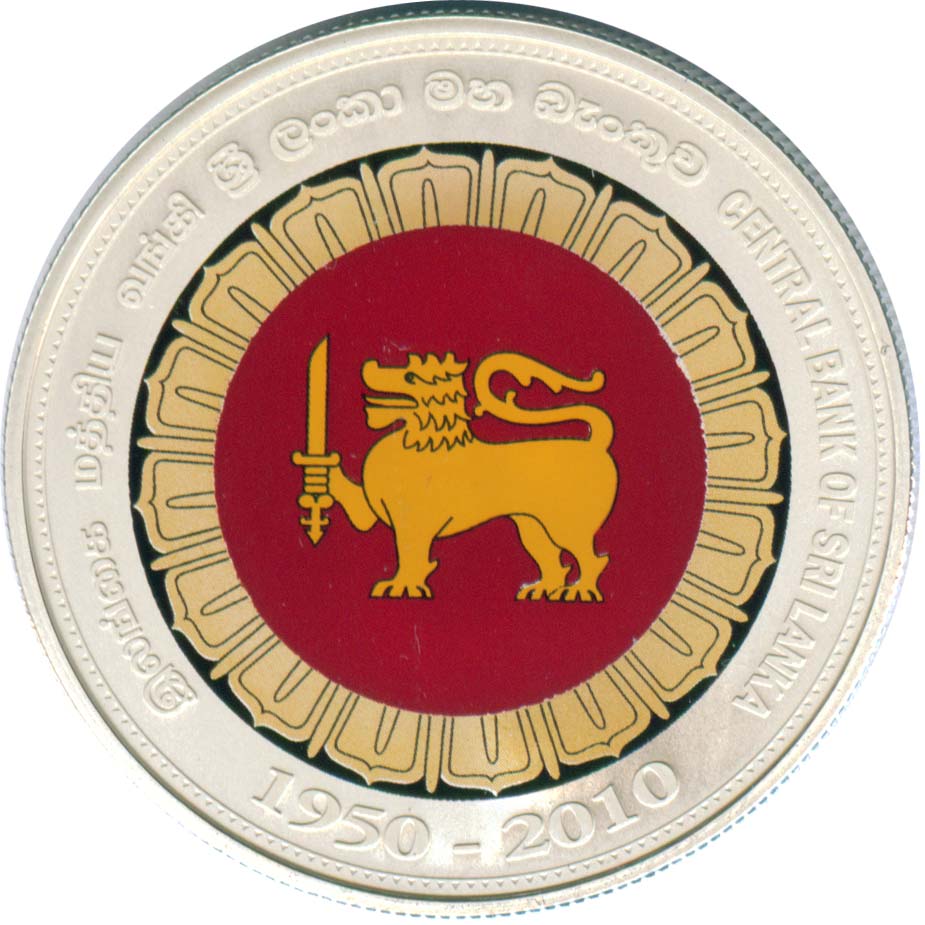
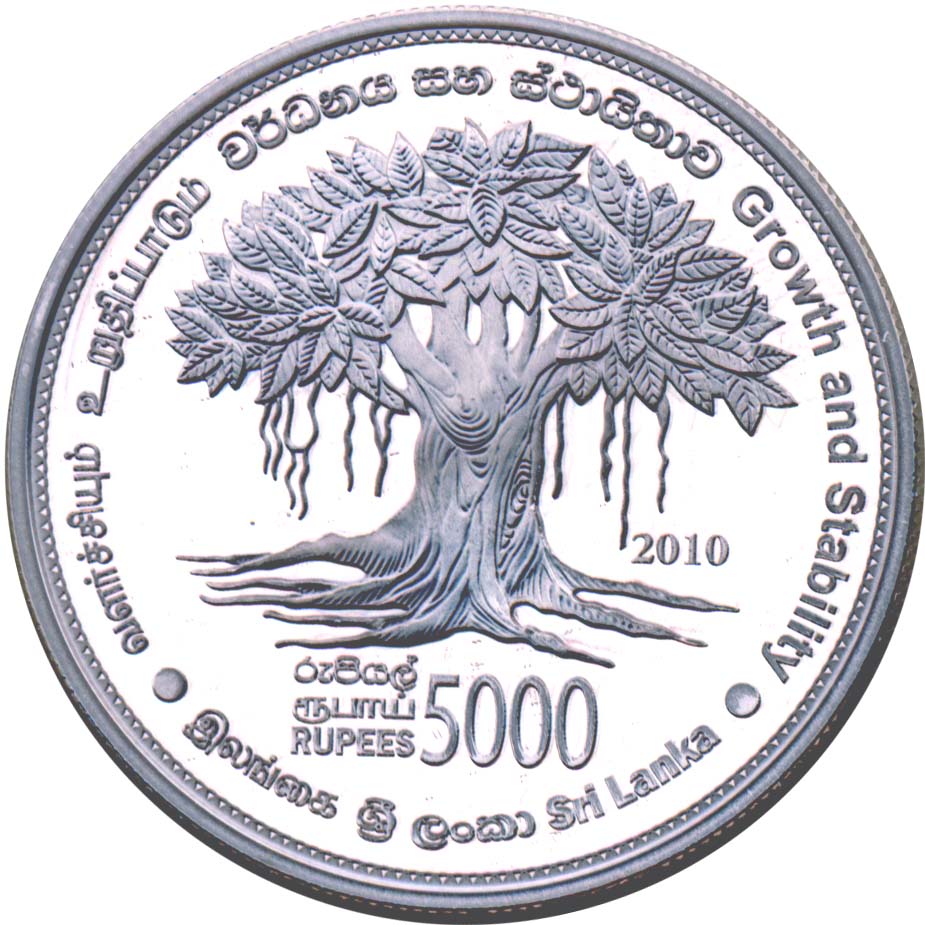





|

|

| ||||||||||||||||||||||

|

| |||||||||||||||||||||||
| KM# 183 | ||||||||||||||||||||||||
Obverse : Crest of the CBSL with the National Flag Lion standing to left with sword in right paw
in a circle of decorative petals in full red and yellow colour in the center and the years
1950-2010 below.
Around the name of Bank
ශ්රී ලංකා මහ
බැංකුව in Sinhala above,
இலங்கை
மத்திய
வங்கி in Thamil on left,
and CENTRAL BANK OF SRI LANKA on right.
All within annulus with a circle of dots along the periphery with raised rim.
Reverse : An artistic Banyan tree with, to symbolizes
the economy of Sri Lanka with the legend
වර්ධනය සහ
ස්ථායිතාව
in Sinhala on top
வளர்ச்சியும்
உறுதிப்பாடும் in Thamil upper left
and Growth and Stability in upper right.
The year of issue 2010 to the left near the roots of tree.
The large numeral denomination 5000 lower right with
රුපියල් in Sinhala,
ரூபாய் in Thamil
and RUPEES in English. to the left of Numeral.
The country name
ශ්රී ලංකා in Sinhala, centered at bottom,
இலங்கை in Thamil
on lower left and SRI LANKA on lower right separeted by two filled circles,
All within a circle of dots along the periphery with raised rim.
The frosted proof coin has been struck with one ounce of sterling silver to the British crown coin size. It is the first multi-colour coin issued by the CBSL. The color image is printed on the coin.
 Enclosed in a circular transparent plastic capsule it is embedded in a black inside a black rexine
covered 7.7cm square spring hinged Royal Mint presentation box. The
Emblem of the Central Bank of Sri Lanka printed in silver on top with
English Text 60th Anniversary - Central Bank of Sri Lanka - 1950 2010
in 3 lines below. Text The Royal Mint with its crest on left printed in black
on the white satin of the inside cover. A locally printed and numbered Certificate
of Authenticity contains the specifications and the text in
Sinhala, English and Tamil.
Enclosed in a circular transparent plastic capsule it is embedded in a black inside a black rexine
covered 7.7cm square spring hinged Royal Mint presentation box. The
Emblem of the Central Bank of Sri Lanka printed in silver on top with
English Text 60th Anniversary - Central Bank of Sri Lanka - 1950 2010
in 3 lines below. Text The Royal Mint with its crest on left printed in black
on the white satin of the inside cover. A locally printed and numbered Certificate
of Authenticity contains the specifications and the text in
Sinhala, English and Tamil.
Artwork designed by Padmanjalie Karunatilleke. Displayed above are scans of Artwork sent to Royal Mint, issued with Press notice. The hanging roots of tree on Minted coin and other minor details are slightly different. The white annulus covers the raised text which is in black in the CBSL logo.
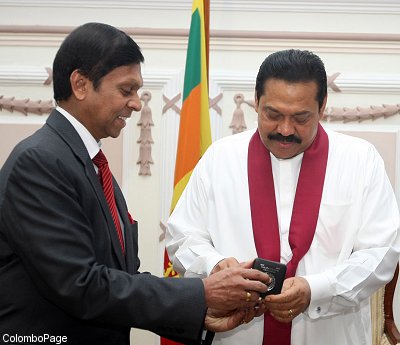 The first coin was ceremonially issued to H.E the President Mahinda
Rajapaksa by Mr. Ajith Nivard Cabral, the Governor of the CBSL on on
2010 December 15th to mark the 60th Anniversary of CBSL on 2010 August
28th. Events
notice originally said 2011 February 27th and was modified to indicate 2011 January 3rd.
Press notice
of 2010 December 14th said it will be issued to public after January 2011. However in view of the large
number of phone calls received by the CBSL, the Governor requested that the small advance consignment
CBSL had got be released to the Public on 2010 December 21st. It was sold to public on that day with
a strict limit of one per customer for the issue price of Rs 7000/- (US $64).
The first coin was ceremonially issued to H.E the President Mahinda
Rajapaksa by Mr. Ajith Nivard Cabral, the Governor of the CBSL on on
2010 December 15th to mark the 60th Anniversary of CBSL on 2010 August
28th. Events
notice originally said 2011 February 27th and was modified to indicate 2011 January 3rd.
Press notice
of 2010 December 14th said it will be issued to public after January 2011. However in view of the large
number of phone calls received by the CBSL, the Governor requested that the small advance consignment
CBSL had got be released to the Public on 2010 December 21st. It was sold to public on that day with
a strict limit of one per customer for the issue price of Rs 7000/- (US $64).
For the 40th Anniversary, CBSL issued the first NCLT coin, at face value of Rs500/-. For the 60th Anniversary CBSL has issued a coin of smiler composition and dimensions with face value of Rs5000/- clearly reflecting the 10-fold depreciation of the Sri Lankan Rupee in 20 years.
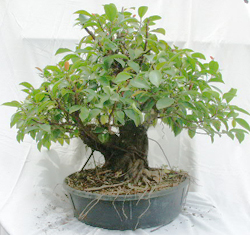 A reader commented that the leaves are not overblown, but that the tree shown is a bonsai Banyan tree.
i.e. Not an overblown economy, but a micro-economy with large aspirations.
A reader commented that the leaves are not overblown, but that the tree shown is a bonsai Banyan tree.
i.e. Not an overblown economy, but a micro-economy with large aspirations.
The suggestion to issues a multcolor coin was made by Mr Ratnasekara the former curator of the CBSL Museum in Rajagiriya. He had shown the Governor a Singapore coin issued in Multicolor.
In 2004 Canada was the first country to issue Colored coins into circulation. A Red Poppy was stamped in pressurized ink on the Canadian Quarter.
The coin was obtained from CBSL on the day issued and scanned at 600 dpi and the images are displayed at 254 dpi.
The printing appears to be 4 color. White, Yellow, Red, and Black. The light yellow, if looked at under 10x magnification shows a fine array of dots (400 dpi). The dots are not seen on other regions of the image which looks almost like a painting than a print. Comparison of coins shows easily identifiable differences. For example locations where the paint of black outline is missing, or the red has not covered the white base, close to the border. I suspect the colour must have been painted via a series of overlaying stencils, probably in the order White, Yellow, Red, and Black. A white base probably covers the full coin face. The central region painted with the other three colors is flat, and if this is required for the painting process, it may explain why the raised text is not black like in the CBSL logo.
I am told the issue price of Rs7000 is very close to the cost of production because of the current melt value of Silver Rs2750. The two IYA2009 Multicolor Silver Proof coins from the Royal Canadian Mint and the Perth Mint cost me around US$90 each. These have only 2 colours and with only one specimen, it is not possible to spot printing errors of this kind to compare with Royal Mint Product.
The 0.2 inch (5mm) square sections below were scanned at 2400 dpi and displayed at that resolution.

| 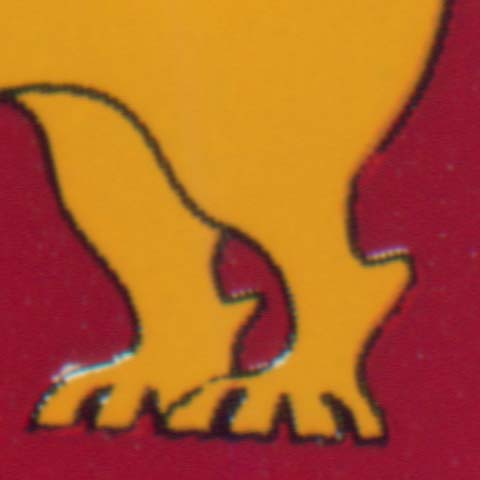
|
| Array of yellow dots printed at 400 dots per inch | Missing regions of red near borders and bits of black outline. |
Gerhard Schoen, wrote
the Royal Mint strikes these coins first without color (i.e. in low
relief), and then applies the printing on the subject by "pad printing"
(so called Tampondruck in German). As the lotus petals are brighter in
color than the lion, and because they only use one yellow color tone
it is necessary to apply grid (yellow dots on white background) in
order to get the lighter yellow tone (just as it is with printing on
paper).
Pad Printing is used to print on 3 dimensional surfaces. Ink is picked up through an etched printing plate for that color to a flexible pad for that color, and then compressed on the print surface to transfer and repeated in sequence for each colour. See Video.
I still don't understand how Pad printing can cause the errors shown
when it can print a much finer grid as for the light Yellow on this coin.

